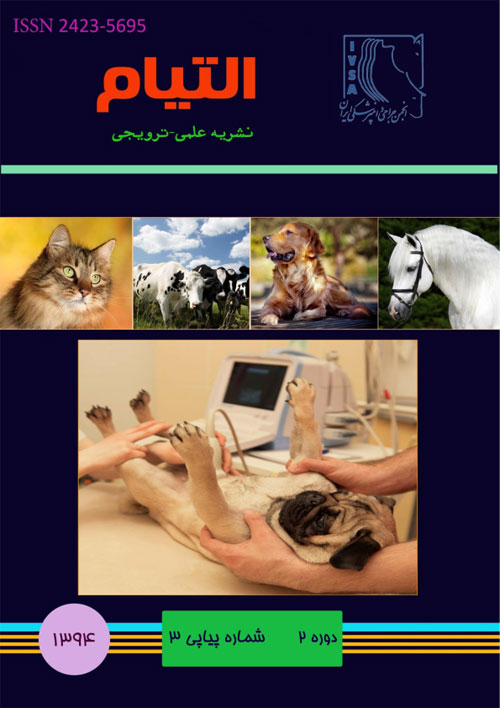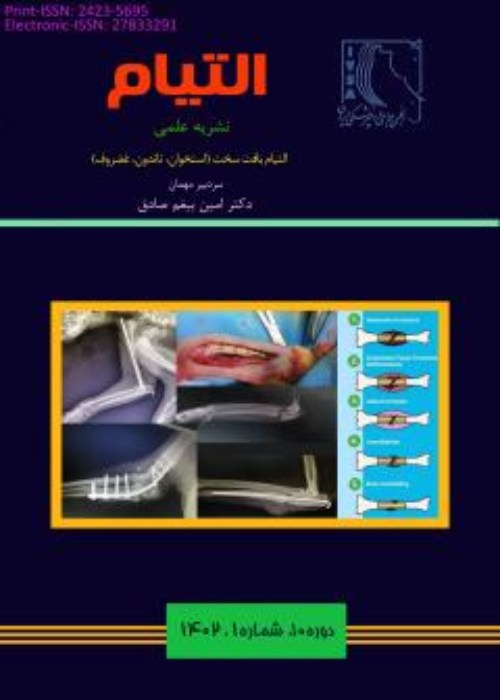فهرست مطالب

نشریه التیام
سال دوم شماره 3 (بهار و تابستان 1394)
- تاریخ انتشار: 1394/06/18
- تعداد عناوین: 9
-
-
صفحه 23
-
صفحه 54
-
Page 4Veterinarians are sometimes asked to anesthetize non-domestic animals. Since physical restraint of wild animals can be dangerous and may result in injury of the personnel or animal, chemical immobilization is the method of choice for most situations. Chemical immobilization of wildlife typically requires remote drug delivery. Remote delivery of injectable anesthetics can be accomplished intramuscularly via pole syringe, blowgun or other power projection systems (pistol and rifle) for short procedures. Generally, inhalation anesthesia is recommended for maintenance of anesthesia. Similar to domestic species, careful monitoring and supportive care are important during anesthesia. The first part of this article focuses on the major principles of wildlife capture, handling and remote drug delivery systems. In the second part, details of the drugs and anesthetic techniques in some wild animal species will be discussed.Keywords: Anesthesia, Remote drug delivery, Wildlife, Restraint
-
Page 14Lameness is of great importance to the dairy cattle industry because of economic and animal welfare considerations. Laminitis is the most important cause of lesions of the horny claw and lameness in cattle. Predisposing factors of laminitis as reported or suggested, are reviewed, including systemic diseases, nutrition, management, calving, age, genetics, conformation, behavior, season and growth. Among these, nutrition (ration formulation and preparation, and feeding program) and housing management are more important. Laminitis in cattle can be seen in acute, sub-acute, chronic and subclinical forms. Subclinical laminitis is the most common form of the disease/syndrome that is of great importance in modern dairy industry. By well recognizing of the laminitis syndrome and using good preventive measures, we can decrease the lameness and it's economic losses in dairy herds.Keywords: Laminitis syndrome, Cow, Lameness
-
Page 23The biology of fracture healing is a complex biological process that follows specific regenerative patterns and involves changes in the expression of several thousand genes. Although there is still much to be learned to fully comprehend the pathways of bone regeneration, the over-all pathways of both the anatomical and biochemical events have been thoroughly investigated. These efforts have provided a general understanding of how fracture healing occurs. Following the initial trauma, bone heals by either direct intramembranous or indirect fracture healing, which consists of both intramembranous and endochondral bone formation. The most common pathway is indirect healing, since direct bone healing requires an anatomical reduction and rigidly stable conditions, commonly only obtained by open reduction and internal fixation. However, when such conditions are achieved, the direct healing cascade allows the bone structure to immediately regenerate anatomical lamellar bone and the Haversian systems without any remodeling steps necessary. In all other non-stable conditions, bone healing follows a specific biological pathway. It involves an acute inflammatory response including the production and release of several important molecules, and the recruitment of mesenchymal stem cells in order to generate a primary cartilaginous callus. This primary callus later undergoes revascularization and calcification, and is finally remodeled to fully restore a normal bone structure. In this article we summarize the basic biology of fracture healing.Keywords: Bone healing, Intramembranous, Endochondral, Callus, Bone trauma, Bone injury
-
Page 33Since majority of the body weight is water, any condition causing dehydration can lead to abnormalities in electrolyte and acid-base imbalances with subsequent death. Diarrhea, shock, and anesthesia are examples of these conditions. Blood gas analyses is a valuable method to determine acid-base status of the body and differentiate metabolic acidosis, metabolic alkalosis, respiratory acidosis, and respiratory alkalosis. Once these four types of imbalances were diagnosed, appropriate treatment can be employed. Fluid therapy is divided to maintenance and replacement therapy. Based on disease status, variety of crystalloid or colloid solutions may be administered.Keywords: Fluid therapy, Electrolytes, Acid, base imbalances
-
Page 39Local anesthesia and analgesia are frequently used in human medicine for management of perioperative pain. These techniques, in addition to providing analgesia during and after surgeries, could reduce the dose of anesthetics and decrease the frequency of administration of systemic analgesics. In recent years and with growing emphasis on improving pain management for animals, using of local anesthesia and analgesia were considered in dogs and cats. Most of the methods used in local anesthesia and analgesia are simple and need no complicated and especial facilities; nevertheless, using different drugs, more advanced equipment, and various methods could improve pain management. The present article is aimed to review the more common drugs, equipment, and methods used in local anesthesia and analgesia of dogs and cats.Keywords: Local anesthesia, Analgesia, Small animals
-
Page 48There is a growing demand for sonography in emergency medicine and veterinarians have widely achieved to this important objective in emergency part and have used it, because of the diagnostic advantage, major advances have been achieved in veterinary sonography technology. Although computed tomography is a selective imaging method for diagnosing post-traumatic bleeding, detecting abdominal injury is difficult and can potentially be fatal such as uncontrollable bleeding. In veterinary, computed tomography (CT) has become a selective imaging method for abdominal injuries. However, access to CT in veterinary medicine is relatively limited. In addition, CT requires the patient to be hemodynamically stable, and needs sedative, general anesthesia or the use of special devices to limit patient that are expensive and non-portable. There are two main types of emergency ultrasound: Full emergency ultrasound and focused emergency ultrasound, which is often called FAST (focused assessment with sonography for trauma). Focused emergency ultrasound technique is a focused examination to achieve quickly important clinical information about emergency patient such as an external object, large masses, gallstones or liquids. Clinical experts (clinicians) can be trained relatively quick, and low-cost and portable ultrasound devices is needed for this purpose. This article reviewed the use of ultrasound by surgeon in abdominal emergency situations.Keywords: Sonography, Emergency medicine, Abdominal cavity, Focused ultrasound technique
-
Page 54Term of bumblefoot is referred to progressive, inflammatory and infected lesion of pedal region in large species of caged raptors. Repeated trauma to the weight-bearing of plantar surfaces and subsequent penetration of pathogens considered the main cause of bumblefoot as a granulomatous disease. Using proper perch and also providing correct and vitamin rich diet are recommended strongly for curative prevention in captive raptors. Based on the extent of the inflammation and infection, different steps of treatment could be performed including: systemic antibiotic therapy, direct intralesional antibiotic delivery, surgical debridement, and postoperative protective foot casting. Present study is intended to describe etiology, histopathology, and diagnosis of bumblefoot and finally encouraged the practitioners to use a multimodal approach for successful management in the injured predatory birds.Keywords: Bumblefoot, Raptors, Surgical debridement, Foot cast
-
Page 62Principled limb and hoof care are the most indispensible issues in equine industry. Nowadays, the role of farriery and hoof trimming in hoof care and lameness treatment are being considered more and more. Veterinarian and farriers believe that ideal farriery is effective in prevention and/or treatment of horse lameness, which results in saving the diagnostic therapeutic expenses while retaining the athletic performance. Dorsal surface of the pastern and dorsal hoof wall (hoof-pastern axis), should be parallel and their changes might result in lameness. Torsional deformity is a consequence of broken hoof-pastern axis associated with chronic arthritis of distal interphalangeal joint. Veterinarians and farriers are able to treat it by modifying the model of shoeing. Navicular bone position makes it much more exposed to the variety of pressures and biomechanical movements. Egg-bar shoe is one of the most popular shoes in Navicular bone diseases. A sheared heel refers to a hoof capsule distortion resulting from displacement of one heel bulb proximally relative to the adjacent heel bulb. Inappropriate lateral medial orientation (imbalance) of the foot landing surface is another common limb problem. The best choice in horses with bruised heel, laminar tearing, sheared and painful heel is heart bar shoe. Equine Digit Support System (EDSS) is an another natural balanced shoe. In this review, relying on importance of integral relationship between veterinarian and farrier, different types of therapeutic shoes that are used in equine limb lesions and diseases, will be introduced and discussed.Keywords: Therapeutic farriery, Limb, Hoof, Horse
-
Page 70Due to social changes that occurred after World War II, public attitudes toward animal welfare have improved and veterinarians are increasingly expected to be informed about animal welfare in a broader sense than health alone. Traditionally, animal use resulting in harm or death in veterinary education in disciplines such as surgery is common worldwide, and there is no doubt that teaching of surgery like other disciplines, at whatever level, is inevitable of adapting with significant modern technological and social changes that affecting all aspects of our lives. However, the veterinary medical education should be refined and animal exploitation in education superseded by using non-harmful alternatives. Veterinary surgery needs to rethink how it can best serve the needs the veterinarian in training along with public expectation. The advancements in new technologies have opened up an excess of sophisticated tools and techniques that potentially can replace the old and outdated educational methods. This author invites veterinary surgeons to join in the ongoing debate favoring the successful adaptation of veterinary surgery to its new social and intellectual environment.Keywords: Education, Surgery, Animal welfare, Educational alternatives


